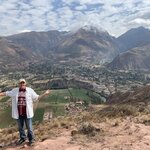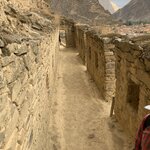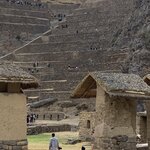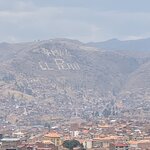Highlights
- Enjoy views of the Inca ruins and the forested peak of Huayna Picchu
- Visit the Temple of the Sun, perfectly positioned for seasonal solstices
- Ascend the staircase to Intihuatana, the most sacred site in Machu Picchu
- Climb Huayna Picchu and visit the Temple of the Moon
Discover Machu Picchu
Machu Picchu is perhaps the most sought-after destination in South America and an unforgettable experience. Part of the wonder of the site is the mystery that surrounds it. The ruins were first discovered in 1911 by Hiram Bingham, a young Yale archaeologist who inspired the character of Indiana Jones.
Historians can only speculate on the site’s original use, but most agree it was probably constructed around the time of Inca ruler Pachacútec in the mid-15th century, and perhaps served as a royal winter retreat from the Cusco cold. Its lack of military significance is probably why it was left untouched by the Spanish conquistadors and lay undiscovered for centuries.
Many photographers say that it’s impossible to take a bad photo of Machu Picchu, such is the magnificent panorama of the Inca buildings and horn-shaped, forested peak of Huayna Picchu. All the more reason to avoid a rushed day trip from Cusco and make the most of your time.
Planning Your Visit

There’s no escaping the fact that those calm moments of wonder you seek at Machu Picchu become harder to attain due to the sheer number of visitors — some 5,000 per day in the peak summer months. Unless you are determined to see the sunrise, note that lines are often very long before dawn and again for the midday entrance when day trippers arrive from Cusco. As tourists leave the site in the late afternoon you start to feel like you have it to yourself.
The least satisfying way of visiting Machu Picchu is a long, exhausting day trip from Cusco when you spend more time traveling and waiting than actually enjoying the site. It’s best to go down in altitude as soon as you arrive in Cusco (3,300 m) and visit the lower Sacred Valley and Machu Picchu over a few days; otherwise, you risk suffering from altitude sickness, particularly if you have arrived by plane. The best options are to spend the night in Ollantaytambo and take the early train or stay in the nearest town Aguas Calientes. It’s also preferable to stay in one of these towns after your visit, rather than rushing all the way back to Cusco.
When to Go
The busiest time to visit Machu Picchu is from late June to the end of August. This is the driest, sunniest period coinciding with the busy school vacations. The rainy season peaks from January to March but the region can be rainy and misty any time. The best times to visit are usually late April to mid-June, and September-October, just outside the rainy season but avoiding the summer rush. The subtropical climate at 2,400 m is generally comfortable though.
There is a certain amount of luck regarding how long you wait in line to enter the site. During the day, it’s often very busy at 6 am when visitors rush to enter the site for sunrise, then quietens down an hour or two later. Lines usually peak again at 11 am to noon when the day trippers arrive from Cusco and quieten down by 2 pm.
See more about when to visit Machu Picchu here.
New Regulations
A new set of rules has been introduced, aimed at preventing the site from becoming a victim of its own success. Entrance tickets are now divided into morning (6 am - midday) and afternoon (midday - 5.30 pm). If you want to stay the entire day then you have to pay the entrance fee twice.
All visitors must now enter with a guide, which is a positive development because the right guide really brings the glory of the site to life with fascinating details. The guided tour takes over 2 hours along a set route, leaving plenty of time to explore the site after the tour. If you wish to climb Huayna Picchu or Machu Picchu mountain after touring the ruins then you must book tickets in advance.
Chat with a local specialist who can help organize your trip.
Top Sights of Machu Picchu

Main Sites in Machu Picchu
Enter the south side of Machu Picchu through the Guards’ Quarters. Then the guide leads you up to the Caretaker’s Hut and the Terrace of the Ceremonial Rock, one of the highest points in the site with excellent views. Beneath the lookout are more than 100 agricultural terraces that provided crops year-round in Inca times.
Continue downhill through the Main Gate, a gigantic entrance door, to the Royal Tomb and the circular walls of the Temple of the Sun, which has windows perfectly positioned for the summer and winter solstices. Continue to the Sacred Plaza with temples on three sides, the most impressive of which is the Principal Temple, constructed with huge horizontal stones.
To the west, climb the staircase of the Intihuatana pyramid, the highest point in the urban area. The centerpiece is an unusual sculpture, considered the most sacred site in Machu Picchu. Further on is the 25-foot-long Sacred Rock and the Artisans’ Wall, arguably the finest wall in the site. The tour ends at the Temple of the Condor where a sculpted rock depicts the bird still revered by the Andean people today.
Walks near Machu Picchu
There are various spectacular walks around Machu Picchu. The shortest and easiest is to the Inca Drawbridge, to the right as you ascend to Caretaker’s Hut. A slightly longer hike, taking about an hour round-trip, is to the Sun Gate. At 2,720 m, this is the highest vantage point to view the ruins, and where trekkers from the Inca Trail first glimpse Machu Picchu. Beyond this is a 3-hour hike to the top of the actual peak, Cerro Machu Picchu (the name translates as “big mountain”).
Hike up Huayna Picchu
By far the most famous hike is to the top of Huayna Picchu, the dramatic forested mountain that looms above the ruins. This slightly hair-raising hike can only be done in the morning. It is very popular, taking nearly 2 hours and, as with Cerro Machu Picchu, must be booked in advance (you are given extra time beyond the morning time slot). Add another hour to visit the nearby Temple of the Moon, an extraordinary construction beneath a giant, overhanging rock.
Trails to Machu Picchu

The best way to enhance your experience of Peru’s Inca heritage is to hike one of the Inca Trails. The Classic 5-Day Inca Trail, done over four days with one more day at the site itself, passes more than 30 Inca sites but can be shortened to 2-days to take in the most impressive ruins. The route can be busy and numbers restricted, so many travelers are now taking alternatives. The Salkantay Trek takes 5-days through spectacular mountain scenery, while the 4-day Inca Jungle Trek, at a more comfortable altitude, focuses on lush scenery with few Inca ruins.
Getting There

The best way to get to Machu Picchu is to hike there (2-day or 4-day treks are possible, see above). This gives you the full Indiana Jones experience of arriving as the early explorers did. The classic Inca Trail arrives directly at the Sun Gate, so there’s no need for a bus ride.
If you don't have time for the trek, the second-best choice is to go by train. There are two companies operating trains to the nearest town Aguas Calientes — Inca Rail and Peru Rail. It’s recommended to book in advance, especially in high season, and particularly if you’re traveling from Cusco. There are better seats and refreshments on the Peru Rail’s Vistadome train service, and true luxury on the very expensive Hiram Bingham service, but the standard Expedition service is of a good standard. Inca Rail offers first class or the standard executive class.
The schedule is subject to change but the first train from Cusco departs at 6.40am, arriving at Aguas Calientes at 9.54am. It’s preferable to travel from nearby Ollantaytambo (1.5 hours) to Aguas Calientes. The first train from Ollantaytambo departs at 5.05am, arriving at 6.35am. There are regular return services from Aguas Calientes in the afternoon and evening but only 3 or 4 direct to Cusco. It’s better to stay in Aguas Calientes the night before visiting Machu Picchu. You then need to get the bus up to Machu Picchu from there (30 minutes).
Food & Lodging

The best – and most expensive – hotel right next to the ruins is the opulent Belmond Sanctuary Lodge. In Aguas Calientes, the top hotel is Inkaterra Machu Picchu Pueblo Hotel with a lush location in the cloud forest, but there are many other hotels catering for all budgets, including Gringo Bill’s, a good mid-range option. In Ollantaytambo, the best-known hotel and restaurant in town is the endearing American-run El Albergue.
For refreshments, there is a café just outside the entrance to the ruins. Dinner options are good in Aguas Calientes and recommended restaurants include the eco-friendly Tree House, which mixes Peruvian and Asian dishes, and Indio Feliz, which expertly blends French and local cuisine.
Expert tips
- Water is not available in the site, so bring a large water bottle (or two) with you. Overpriced bottles of water are for sale just outside the site. Eat before entering because food is not allowed in the site.
- Weather is changeable so be prepared for both strong sun and rain. Bring sunblock, hat, rain gear, walking shoes and mosquito repellent. A small umbrella is also handy.
- Note that only small luggage is permitted on the train, so pack essentials and leave any big suitcases in your hotel in Ollantaytambo or Cusco.
- Some unscrupulous restaurants in the area add a 20% "special tax" to your bill at the end of a meal. This is usually not stated on menus so it's best to ask if such a tax is added before ordering.
- Fun fact: It's possible to get a Machu Picchu stamp in your passport, so ask for this on your way out.








